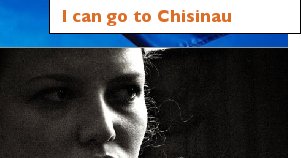Why did you plan to go to the EU?
Every time I have planned to travel to the EU I had a very good motivation (perhaps this is the first condition for being sure that you can go to the embassy). As an active young person I am involved in different activities that give me the possibility to attend different international and European events (most of them organized by JEF-Europe): conferences, trainings, seminars. That is why I had good and bad experiences at the embassies EU member states for getting a visa for each trip.
What were the steps you had to take before being able to book your flights/train?
The first step that a non-EU citizen has to take before making plans about a trip to an EU country is to check which embassy he needs to go to. You often have the situation that you don’t have the embassy of the country you have to travel to in your home country, so you usually have to go to a neighbouring country in order to get a Schengen visa. Let’s take the example of Moldova: the visa for Belgium is issued by the embassy located in Romania, which means you first have to apply for a visa to Romania (as Romania is in the EU) in Moldova and once you receive this, you have to travel quite a while and pay the train or plane tickets by yourself to go to the Belgian embassy in Romania. If the embassy is in your home country it is easier to apply and to receive your visa.
The second step to receive a visa is to fill out a big file with all the necessary documents that are required by each embassy. You have to make an appointment with the consular worker in order to submit your file. During the meeting you have an interview about your current status: work, family, studies, activity, income resources and reasons for your trip; if you have other visa stamps in your passport you can be asked to explain about the reasons for your previous trips. In fact, the questions and the papers required are different depending on what kind of visa you need: study visa, touristic visa or travel for business, cultural, sportive and/or health reasons.
After the interview you need to wait at least 10 days before you get an answer that can be positive: this means you can book your flight/train ticket and think about your trip. Or it can be negative: you do not have the possibility to apply again for your visa and you will stay at home.
What documents did you have to provide to the authorities to be able to travel to the EU?
In order to travel to the EU for an international event, project, conference or seminar you have to complete a big file with a lot of documents: Of course, first of all you should check if your passport is valid for up to 6 months after the visa expires. You must fill in a standard “visa form” that contains all information about you, your parents and your activities, documents, reason and period of your trip, the information about the host in the EU country (hotel, friend, relative), your insurance, etc. Attached to this form you must have an original official invitation letter from the organisation/person that is inviting you to the EU in order to justify your legal stay there. In order to explain your activity in the home country you must present a study or work certificate. Plus, you should have health insurance for the travel period and the proof of the booked ticket and hotel reservation in the country that you are going to stay at. Also, you can be asked to prove your financial income by presenting a bank statement from your account (for Moldova, in order to get a visa to Romania you should have 500 EUR on your bank account).
How long did it take to receive confirmation that you can travel?
It takes at least 10 days to have the confirmation that you can travel. But you can be in the situation that after 10 days you will be announced that you didn’t get your visa. The examination period of your file can take more than 14 days, but it depends on the reasons for travel and the country. However, you can ask for a short examination period if you can prove that you need the visa urgently. This possibility is very uncertain because you never know if your situation or reason will be taken into the consideration and will be analysed as a priority. The reasons for urgently checking documents for visa remain at the discretion of the visa issuing authority (these cases are very rare).
Did you have to pay to be able to travel to the EU?
There is a tax to pay for your visa application: 35 EUR. Plus, you have to pay another consular tax and the final amount can be about 65 or 70 EUR which is often inaccessible for young people or for students. The most unpleasant thing is the fact that the paid amount is not refunded if you don’t get the visa.
What happened at the frontier (i.e. controls, which documents to show, justifications etc.)?
At the frontier to enter the EU you have to pass two types of controls. The first control is the internal one, when you leave your country. It happens at the national frontier, in front of the national authorities. Here your passport is checked, if it is valid and if you have a visa in order to leave your home country. Also, you can be asked about the reason and the period that you are going to be abroad. The second one is at the international frontier, i.e. the one when you arrive in the EU country. Here, your passport is checked at the non-EU gates and you are asked about your reason of staying in an EU country and you are invited to present the justification document of your legal stay (invitation letter). You are asked to present the return ticket to your home country as well.
My passport is stamped every time I leave Moldova (national stamp) at the national borders and when I come to EU – at the European borders. When I come back my passport is stamped too, by the same authorities. So after each trip to the EU I have 4 stamps in my passport for the round trip. The Moldovan passport is provided with special pages for the visa card and with pages where you should have all stamps applied at all borders that you have to pass.
... most Moldovan young people often cannot travel abroad without complications and bad experience
How long are you allowed to stay in the EU?
It depends on the type of visa that you have in your passport. For regular visa - most of the cases - your stay in the EU country is provided in accordance with the number of days indicated in your invitation letter depending of the event (1, 3, 6, 20 days). If you asked for a long stay visa you can get your visa for maximum 6 or 12 months. Also, you can apply for a multi-entry visa that gives you the possibility to enter the EU territory several times during the permitted period provided by the visa. In all these cases you must prove the necessity of your stay for one period or another.
What was your experience when staying abroad?
For me each trip to the EU is a very interesting and good experience. Every time is different and I am sure that I can learn something new. I had the possibility to participate in different international seminars, trainings, conferences (organized by JEF Europe, JEF Montenegro, JEF France, JEF Norway, etc.) and international law competitions. Thus, I discover every time the beauty and the goodwill of people from the EU countries. Also, I had the opportunity to study in France, and this international experience was one of the most enjoyable and useful. I can say that I am lucky because I managed to get a visa every time and to make such wonderful experiences. However, I cannot say the same about most Moldovan young people who often cannot travel abroad without complications and bad experience.
How was the journey back to your home country?
It is stressful as you have to pass the two border controls again the other way around - EU and national. The same passport controls take place sometimes with the same questions: about your trip, the reason of the trip, the staying period. So when you go back to Moldova you also have to justify why you have been in the EU and when you leave the EU they control your passport.
Would you be allowed to go back to an EU country now that you have been there once?
Not without getting another visa for the EU country I want to travel to. I must go through the same procedure at the embassy with a new file, fees and the interview.
What would you wish for to improve travelling to the EU?
NO MORE VISA requirement! The abolishment of visas is the most necessary and useful measure that can facilitate my traveling to the EU!


1. On 2 October 2010 at 17:57, by Convicted European Replying to: Schengen Visa: the invisible wall
Replying to: Schengen Visa: the invisible wall
Dear Daniela,
thank you for sharing your personal experiences in the form of this interview with us. I was wondering if you could elaborate a bit more on how you think organisations such as JEF and others can help young Moldovan citizens with the issues of visa and mobility. Moreover, it would be great to hear if you have some information about the possible change of attitudes and procedures of acquiring a Schengen Visa after the Community Code on Visas (CCV) entered into force in April 2010?
Follow the comments: |
|
